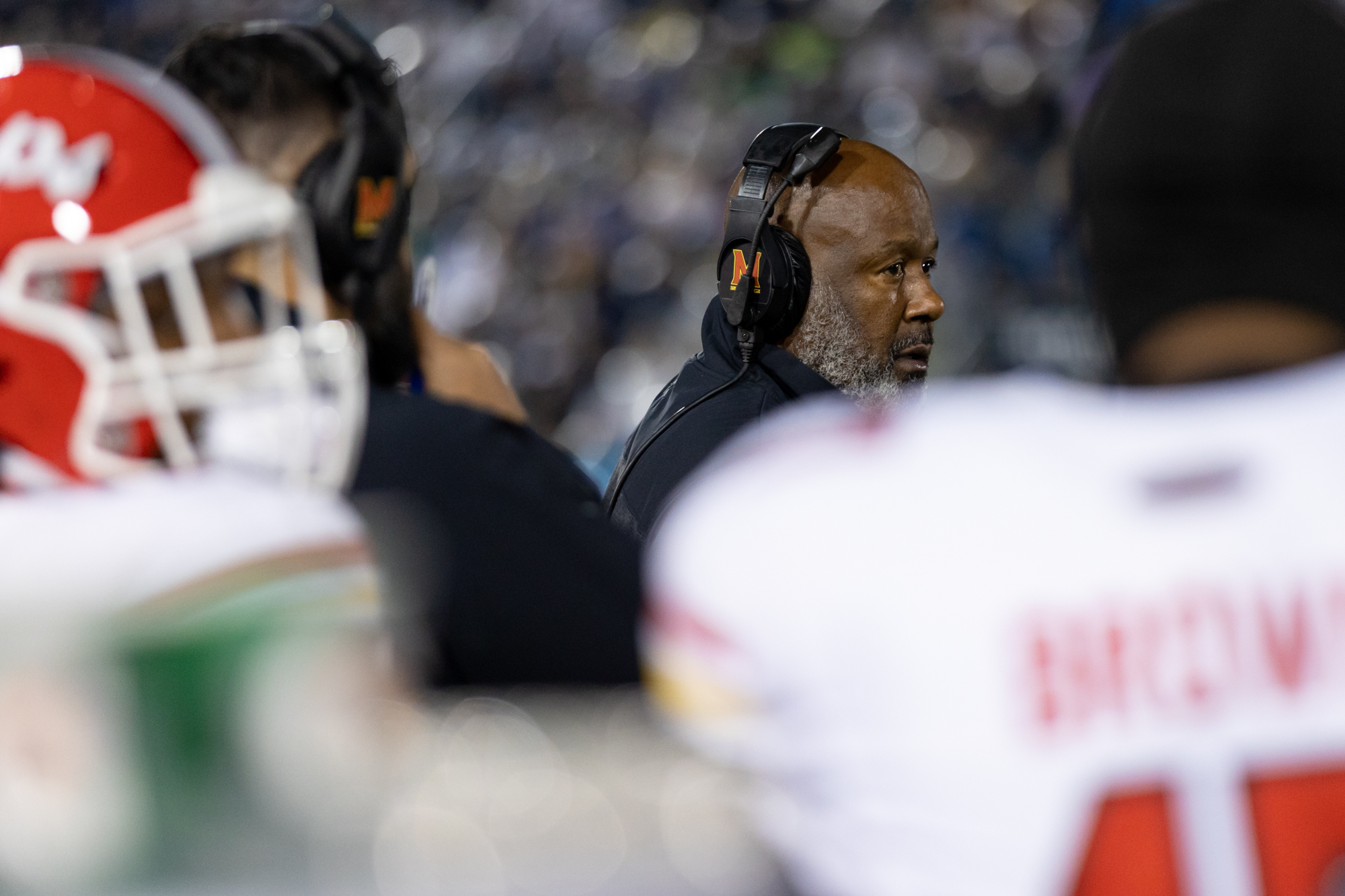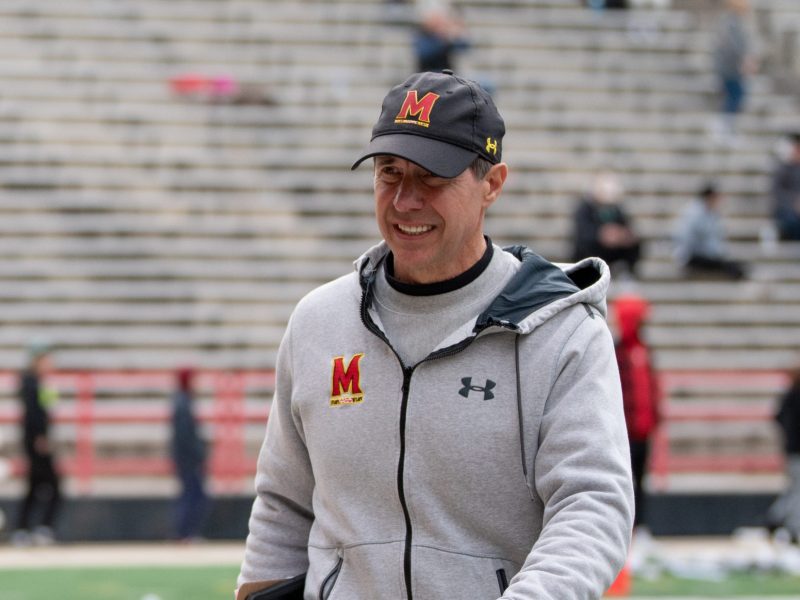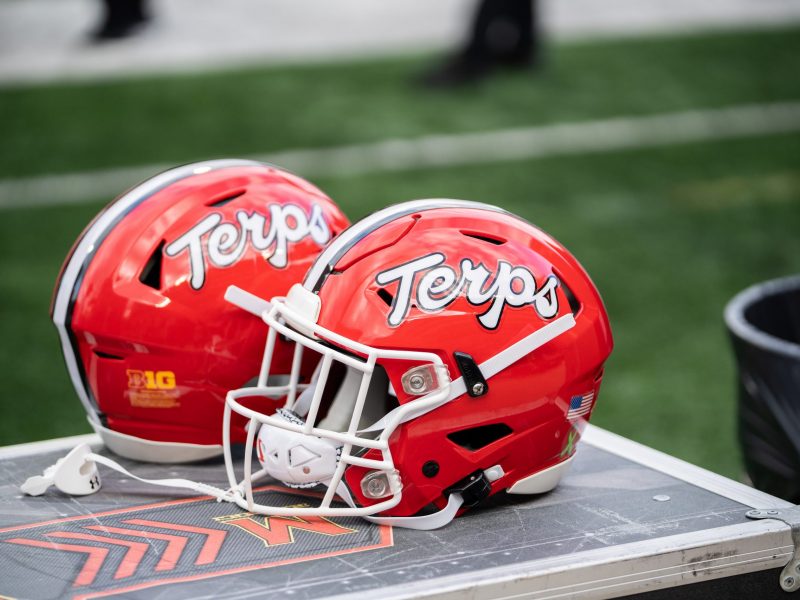By Noah Ferguson and Varun Shankar
Maryland football had its most successful season in head coach Mike Locksley’s tenure in 2022, with eight wins and the program’s second-straight bowl berth.
With the Terps ready to play their spring game Saturday and showcasing a look at what the 2023 squad could look like, The Diamondback’s football reporters examined key stats that defined last year’s Terps and could play a role in their success next season.
143: The number of dropbacks Taulia Tagovailoa was pressured on in 2022, second-highest among Big Ten quarterbacks.
After an Indiana defender hit Taulia Tagovailoa during Maryland’s mid-October win, the quarterback was eventually carted off.
The injury, a reaggravation of an earlier MCL sprain, forced Tagovailoa to miss a game. The 5-foot-11 quarterback is on the smaller side of most signal-callers but took punishing hits during the 2022 season.
That season’s campaign will likely be remembered as one where Tagovailoa broke multiple Maryland records. But he spent almost a third of his snaps under duress and led the Big Ten in sacks taken with 34.
When he returned, the poundings resumed. Tagovailoa got sacked 12 times across the Terps’ games against Wisconsin and Penn State. In those games, the quarterback failed to clear 80 passing yards in back-to-back weeks.
Locksley didn’t place blame solely on Tagovailoa or the Terps’ offensive line after the team’s shutout loss to the Nittany Lions.
“Have we protected him very well? No we haven’t,” he said. “But there were opportunities for him to maybe not take as many sacks by getting the ball out … it’s about being very disciplined and not looking at the rush because he’s got beat up the last couple of games.”
Locksley said the Terps were looking to protect their quarterback – calling plays that allow him to get the ball out of his hands quickly to avoid those hits. Tagovailoa agreed with the assessment, saying he needed to make quicker decisions.
In the next game against Ohio State, the quarterback took five sacks but threw for 293 yards and two touchdowns, averaging 2.56 seconds before throwing on his dropbacks, tying his season-low according to Pro Football Focus.
Tagovailoa averaged 2.99 seconds before throwing the ball last season overall. That mark was the highest among Big Ten quarterbacks with at least ten starts and a slight increase from his 2021 time of 2.76 seconds per Pro Football Focus.
He led the league with 25 scrambles according to Pro Football Focus, but they came at a price. The quarterback looked battered at multiple points during the year.
Taulia Tagovailoa heads to the injury tent after this hit pic.twitter.com/Tg8eTgCY5R
— FOX College Football (@CFBONFOX) September 24, 2022
Maryland had a veteran offensive line last year with multiple potential NFL draft picks. But the Terps will need to replace four of its five starters – left tackle Jaelyn Duncan, left guard Mason Lunsford, center Johari Branch and right guard Spencer Anderson – as well as backup center Coltin Deery.
As Tagovailoa enters his fourth season as a Maryland starter, he will need to utilize this experience to better manage pressure and limit the hits he takes with a fresh offensive line.
[Maryland football to wear retro “Terps Script” uniforms in 2023 and beyond]
10: Corey Dyches’ deep ball targets in 2022
Locksley called Corey Dyches a “weapon” following the tight end’s junior season, a well-earned moniker after Dyches’ improvement in 2022. The 6-foot-2, All-Big Ten honorable mention helped fill the void left after Chigoziem Okonkwo departed to the NFL, finishing with 494 yards and three touchdowns last season.
Nearly 200 of those yards came from passes thrown at least 20 yards down the field, by far the highest mark of any 2022 Big Ten tight end per Pro Football Focus. Dyches’ 10 deep ball targets were also a conference-high.
Dyches’ standout performance came in Maryland’s 31-29 loss to Purdue in early October. With seconds remaining in the first half and the Terps in a seven-point hole, quarterback Taulia Tagovailoa fluttered a pass more than 30 yards downfield toward his tight end.
Dyches hauled the ball in and carried a defender on his back for 15 yards into the endzone for a late score — one of the junior’s two touchdowns that day. He finished the game with a team-high 106 yards.
When Dyches returns for his fourth season with the Terps, he’ll encounter some new faces in the tight ends room.
Fellow tight end CJ Dippre, who caught 30 passes and logged three touchdowns last season, transferred to Alabama in the offseason. Last season’s tight ends coach Mike Miller also left Maryland during the offseason and was replaced by Kevin Sumlin.
43.3: The percentage of targets Deonte Banks allowed catches on, the 10th-lowest Power Five mark among cornerbacks with at least 300 coverage snaps.
Deonte Banks played two games during the 2021 season before suffering a shoulder injury that cut his junior year short. After a difficult time away from football, the cornerback’s 2022 season rocketed him to be widely considered a first round pick.
“Deonte, he can just do a lot,” teammate Tarheeb Still said in December. “He could really just line up a lot of places, cover a lot of different types of people, tight ends, slots, outside receivers … you put him out there to really just go on an island and just go at it with your number one.”
Still and Jakorian Bennett joined Banks in 2022 to form an imposing cornerback trio. That wasn’t the case in 2021 after Banks’ injury. Three corners took replaced the bulk of his outside snaps in 2021 — Lavonte Gater, Corey Coley Jr. and Kenny Bennett.
The trio played a total of 410 coverage snaps in 2021 compared to Banks’ 384 in 2022 according to Pro Football Focus. In 2021, they allowed catches on 57.4 percent of targets, dramatically higher than Banks’ 43.3 percent.
Gater, Coley and Bennett combined to give up 420 yards, break up four passes and only force six incompletions. In 2022, Banks gave up 258 yards, broke up eight passes and forced 13 incompletions according to Pro Football Focus.
A Deonte INT#TBIA pic.twitter.com/nFlIuxYrxd
— Maryland Football (@TerpsFootball) October 16, 2022
Banks, a former three-star recruit from Edgewood, is gone now, pursuing what could be a prolific NFL career. His departure forces the Terps to replace a football unicorn – the shutdown cornerback.
[Duke’s Mayo Bowl gives Maryland football a first look at its future]
3.93: Antwain Littleton II’s average yards after contact per rush
Before the 2022 season began, Locksley expressed his excitement in the potential of his young running backs. The Terps had lost Tayon Fleet-Davis to the NFL and put their trust in freshmen running backs Roman Hemby and Antwain Littleton II for the majority of touches in the backfield.
That trust paid off. Hemby recorded 924 rushing yards on the season while Littleton bulldozed his way into the endzone for five touchdowns, spearheading a unit that gave the offense multiple ways to attack. Hemby was named a 2022 All-Big Ten honorable mention in his first full season with the Terps.
“Roman Hemby came through big, big runs, big-time plays,” Locksley said after a dominant Hemby outing against Northwestern in October. “He showed exactly what we talk about, his ability to hit the home run. It couldn’t have happened at a better time for us, we needed it.”
One of the main keys to Hemby and Littleton’s success out of the backfield was their ability to break tackles and extend plays through contact. Hemby racked up 525 yards after contact on the year in 187 carries while Littleton racked up 303 in just 77 per Pro Football Focus.
-36: Maryland’s combined scoring margin against its four toughest conference opponents
Heading into the 2022-23 season, the Terps were a combined 4-25 against Big Ten juggernauts Ohio State, Penn State, Michigan and Michigan State since joining the conference in 2014.
Locksley’s squad was on the heels of a 49-point drubbing to the Buckeyes and a 41-point defeat to the Wolverines in 2021 – poor performances that proved the Terps had a long way to go before they could contend for the Big Ten title.
“I know people say we want to ‘close the gap’ between the top teams,” Locksley said ahead of the 2022-23 season. “We got a tough league, we understand that, but it’s still going to be more about what we do than it is what they do.”
While Maryland didn’t get over the hump this season against the Buckeyes or Wolverines, the Terps showed sizable improvement based on each game’s box score.
A year ago, Maryland trailed by 25 points at halftime against Ohio State. A year later in 2022, it entered halftime leading the perennial Big Ten powerhouse by three points. The team was a miracle drive away from stunning the Buckeyes in the game’s closing moments.
Despite giving up a touchdown seconds into their road game against Michigan, the Terps lost in Ann Arbor by just seven points. Locksley’s squad beat Michigan State at home for the first time in six seasons – a game that featured a 314-yard passing performance from Tagovailoa and a 175-yard rushing performance as a team.
Still, the Terps failed to avoid a blowout loss in their 2022 campaign. Maryland never got on the board in a 30-0 drubbing at Penn State, the only time Locksley’s squad lost by more than two possessions this season.



